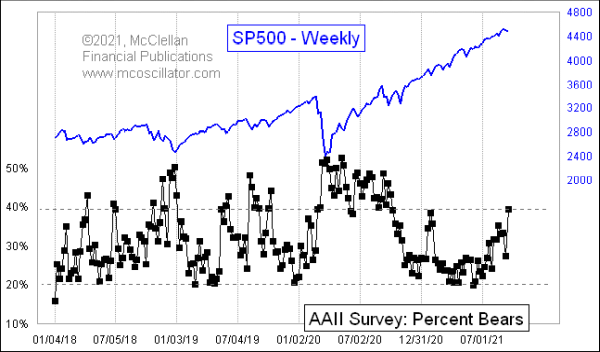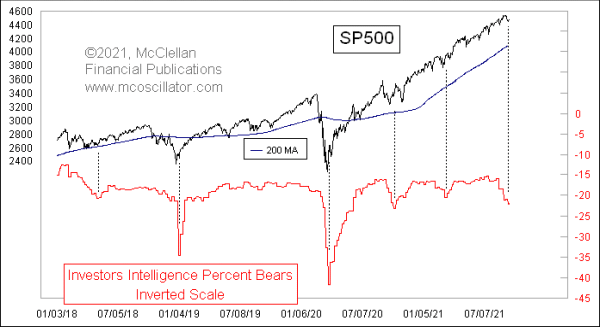
With rising worries about September’s bad reputation for the stock market, and with a small drawdown in stock prices, investors seem to have suddenly turned a lot more bearish. That bearishness constitutes fuel for sustaining an uptrend, as all of those bears will turn into buyers as they flip back to a less bearish stance.
This week’s chart shows data from the AAII’s weekly survey of its members. The raw data are available at www.aaii.com/files/surveys/sentiment.xls. Some analysts like to track the spread between bulls and bears in this survey, and I watch that too. But I also find that just looking at each of them separately can be useful.
This is the highest reading for the bearish percentage since October 2020, when we were still just recovering from the Covid Crash, and investors were still terribly pessimistic. This is a bottoming sort of indication for stock prices.
It matches what we have seen in the Investors Intelligence survey, which looks at a relatively fixed pool of investment advisors and newsletter writers. Here is their bearish percentage, presented on an inverted scale to better correlate with stock prices:

Normally it takes actual downward price movement to turn people to a more bearish state. We have not had much of that this time. I suspect that this rise in bearishness this year has been fueled by more discussion than normal about weak seasonality in September. I have noticed more discussions about it on Twitter and on CNBC, and even Jim Cramer has reportedly been talking about it.
There are discussions of it every year, and for good reason since the point is true about September being statistically a bearish month for the stock market. But it does not get the same attention every year, and this year it just seems to be more of a discussion topic, resulting in people feeling it more.
That pessimism is also likely getting some fuel from the recent events in Afghanistan, where it looks like an out of control situation with no solution. We saw similar spikes in investor bearishness during the Ebola panic in October 2014, the Fukushima earthquake and nuclear accident in March 2011, and the Deepwater Horizon disaster in 2010. When there is a general feeling of a lack of control, people turn pessimistic even in spite of what stock prices are actually doing.
Tom McClellan
Editor, The McClellan Market Report